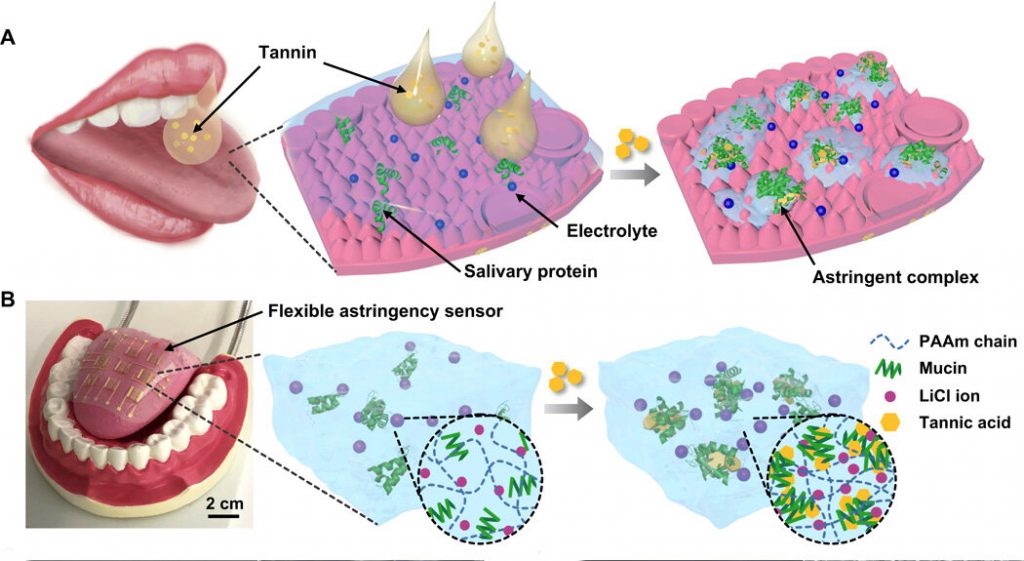Although the judgment of taste is merely subjective, the manufacturing of pharmaceutical and food products require objective taste evaluation. A new artificial tongue that could help standardize the subjective perception of taste has been developed.
A research team, led by Professor Hyunhyub Ko in the School of Energy and Chemical Engineering at UNIST, has created an artificial tongue that fully mimicks human tongue–like performance for tastes, such as astringency. Mimicking the sensing mechanisms of the human tongue, this artificial tongue can serve as a new quantitative prediction approach for astringency, and thus would have wide application in new food and drinks product development, as well as for the monitoring of fruit trees.
The dry and puckery feeling in the mouth following the consumption of unripe fruits, red wine or tea is due to the astringency from the tannin. Unlike the five basic tastes, astringency is perceived by the strong association of ingested astringent tastants and saliva proteins covering the tongue. When astringent tastants enter the oral cavity, they bind with secreted proteins to form insoluble precipitates on the tongue, resulting in shrinkage of the epithelium that causes dryness and a puckering feeling in the mouth. On the other hand, sweet and salty tastes are perceived by taste buds found on your tongue. Since astringency is not a receptor-binding sensation, it is therefore necessary to develop an artificial tongue that fully emulate the sensing mechanism of astringency.

(Top) Schematic illustration of astringency sensing principle of the human tongue. (Bottom) Photograph of artificial tongue and schematic illustration of the astringency sensing principle of artificial tongue.
Inspired by the sensing mechanism of oral dryness caused by astringent tastants, the researchers designed a soft hydrogel–based artificial tongue, which is a saliva-like ionic PAAm hydrogel containing mucin proteins and lithium chloride (LiCl) electrolytes. As a representative polyphenolic substance, the researchers used tannic acid (TA). When TA solution diffuses into the hydrogel matrix, incoming TA molecules bind and complex with the mucin to form hydrophobic aggregates and further transform the microporous hydrogel into the hierarchical micro/nanoporous structure, resulting in enhanced ionic conductivity.
“Due to the hydrophobic aggregates, the hydrophobic surface of the microporous hydrogel changes to hydrophilic, which results in the reduction of electrostatic interactions between ions and the pore walls” says Ayoung Choe, the first co-author of the study. “And this results in enhanced ion transport through the hierarchical porous structures.”
Using the new flexible astringency sensors, researchers conducted an experiment to detect the degree of astringency in real beverages (white wine, rose wine, red wine, and black tea leaves with different brewing times) and monitor the ripening of fruits. Their results showed that the new sensor exhibits a wide sensing range (2.9 to 5880 μM) that covers human sensing threshold (30 μM) and fast response time (~10 s) without adopting real taste cells or a sophisticated fabrication process.

Applications of the artificial tongue. (A, B) Schematic illustration of wipe-and-detection of the human tongue and artificial tongue. (C, D) Astringency detection of unriped (left) and riped (right) persimmons
“Trained experts can detect the astringency concentrations of tens of micromolar (μM), yet with the use of the new soft hydrogel–based artificial tongue, it is now possible to even detect astringent compounds in the 2–3 μm range,” says Jeonghee Yeom (Combined MS/Ph.D program of Energy and Chemical Engineering, UNIST), the first author of the study.
“Our discovery led to the creation of the miniaturized artificial tongue for astringency perception, using low-cost and flexible materials,” says Professor Ko. “Our sensor can detect the degree of astringency in beverages and fruits using a simple wipe-and-detection method, making a powerful platform for future applications involving humanoid robots and taste monitoring devices.”
The findings of this research have been published in Science Advances, a sister journal of Science on June 6, 2020. This study has been supported by the Mid-Career Researcher Program through the National Research Foundation of Korea (NRF).
Journal Reference
Jeonghee Yeom, Ayoung Choe, Seongdong Lim, et al., “Soft and ion-conducting hydrogel artificial tongue for astringency perception,” Science Advances, (2020).

















